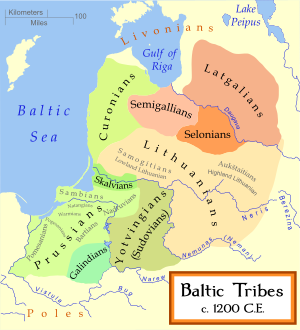Livonia
- This article is about the region in Europe. For other uses see Livonia (disambiguation).
Livonia (Livonian and Latvian: Livonija; Estonian: Liivimaa; German: Livland; Swedish: Livland; Polish: Liwlandia; Russian: Лифляндия or Lifljandija; Lithuanian: Livonija ) once was the land of the Finnic Livonians, but came in the Middle Ages to designate a much broader territory controlled by the Livonian Order on the eastern coasts of the Baltic Sea in present-day Latvia and Estonia. Its frontiers are the Gulf of Riga and the Gulf of Finland in the north-west, Lake Peipus and Russia to the east, and Lithuania to the south.
Livonia was inhabited by various Baltic and Finnic peoples ruled by an upper class of Baltic Germans. Over the course of time some nobles were polonized into the Polish-Lithuanian nobility (Szlachta) or russified into the Russian nobility (Dvoryanstvo).
History
Beginning in the 12th century Livonia was an area of economic and political expansion by Danes and Germans, particularly by the Hanseatic League and the Cistercian Order. Around 1160 Hanseatic traders from Lübeck established a trading post at the future site of Riga.

Teutonic-Estonian War
The Chronicle of Henry of Livonia from the 1220s gives a firsthand account of the Christianization of Livonia, granted as a fief by the Hohenstaufen King of Germany Philip of Swabia to Albert of Buxhoeveden, nephew of the Archbishop of Bremen, who sailed with a convoy of ships filled with armed crusaders to carve out a Catholic territory in the East during the Northern Crusades. Albert founded Riga in 1201, built a cathedral, and became the first Prince-Bishop of Livonia.
Monastic State of the Teutonic Knights
Thus, from the early 13th century Livonia became a confederation (Livonian Confederation) of lands ruled by the Livonian Order (founded by Albert in 1202, which joined with the Teutonic Knights in Prussia in 1237) and the spiritual territories including the Archbishopric of Riga and the Bishoprics of Courland, Ösel-Wiek, and Dorpat, where Albert's brother Hermann established himself as the prince-bishop. The conquest of Livonia by the Germans is described in the Livonian Rhymed Chronicle.
In 1561 during the Livonian War Livonia fell to the Grand Duchy of Lithuania [1][2][3] with vassal dependency from Lithuania[3]. Eight years later, in 1569, when Grand Duchy of Lithuania and Kingdom of Poland formed Polish-Lithuanian Commonwealth, Livonia became a joint domain administered directly by the King and Grand Duke. [3][1][4][5][6][7]

Russia recognized Polish-Lithuanian control of Livonia only in 1582. As of 1598 it was divided onto:
- Wenden Voivodeship (województwo wendeńskie, Cēsis / Wenden)
- Dorpat Voivodeship (województwo dorpackie, Tartu / Dorpat)
- Parnawa Voivodeship (województwo parnawskie, Pärnu / Pernau / Parnawa)
Sweden gained control over the northern Estonian and central Latvian regions of Livonia, including Riga, after fighting the Polish-Swedish War during the 1620s, and incorporated it into the Swedish realm as the dominion Swedish Livonia. The portion of Livonia remaining in the Commonwealth after the Treaty of Oliva in 1660 was known as Polish Livonia, or Inflanty. It consisted mainly of the southern Latvian region Latgale within the Livonian Voivodeship with the capital of Daugavpils, or Dyneburg. This division of Livonia was codified in the Treaty of Oliva in 1660.
The Russian Empire conquered Swedish Livonia during the course of the Great Northern War and acquired the province at the Treaty of Nystad in 1721. Russia then added Polish Livonia in 1772 during the Partitions of Poland.
United Baltic Duchy
Livonia remained within the Russian Empire until the end of World War I, when it was split between the newly independent states of Latvia and Estonia. In 1918-1920 both Soviet troops and German Freikorps fought against Latvian and Estonian troops for control over Livonia, but their attempts were defeated.
Reichskommissariat Ostland
The historical land of Livonia as been split between Latvia and Estonia ever since.
The native Livonian language is still spoken in parts of Latvia, but is understood to be fast approaching extinction.
The anthem (probably unofficial) of Livonia was Min izāmō, min sindimō.
Notes and references
- In-line:
- ^ a b Template:Lt icon Alfredas Bumblauskas (2005). Senosios Lietuvos istorija 1009 - 1795. Vilnius: R. Paknio leidykla. pp. 256–259. ISBN 9986-830-89-3.
- ^ Template:En icon Robert Auty (1981). D. Obolensky (ed.). Companion to Russian Studies: Volume 1 Vol 1 Introduction to Russian History. Cambridge: Cambridge University Press. p. 101. ISBN 0-521-28038-9.
- ^ a b c Template:En icon Szilvia Rédey, Endre Bojtár (1999). Foreword to the Past: a cultural history of the Baltic People. Central European University Press. p. 172. ISBN 963-9116-42-4.
- ^ Template:En icon Norman Davies (1996). Europe: a History. Oxford: Oxford University Press. p. 555. ISBN 0-19-820171-0.
- ^ Template:En icon George Miller (1832). "Modern History". History, philosophically issustrated, from the fall of the Roman empire to the French revolution. p. 258.
{{cite book}}: Cite has empty unknown parameters:|chapterurl=and|coauthors=(help) - ^ Template:En icon Alfrēds Bīlmanis (1945). Baltic Essays. The Latvian Legation. pp. 69–80. ASIN B0007E4DI4.
{{cite book}}: Cite has empty unknown parameters:|chapterurl=and|coauthors=(help) - ^ Template:En icon Beresford James Kidd (1933). The Counter-reformation, 1550-1600. Society for promoting Christian knowledge. p. 121.
{{cite book}}: Cite has empty unknown parameters:|chapterurl=and|coauthors=(help)
See also
- Archbishopric of Riga
- Bishopric of Courland
- Bishopric of Dorpat
- Bishopric of Ösel-Wiek
- Bishopric of Reval
- Courland
- Duchy of Courland
- Duchy of Livonia
- Inflanty
- Kingdom of Livonia
- Livonian Brothers of the Sword
- Monastic State of the Teutonic Knights
- Principality of Estland
- Reichskommissariat Ostland
- Riga Governorate
- Swedish Livonia
- United Baltic Duchy
- History of Estonia
- History of Latvia
- History of Lithuania
- History of Poland
External links
- Deutsch-Baltische Ritterschaften in Livland, Kurland, Estland, Oesel
- Die Geschichte der Deutschen im Baltikum
- Die Livländische Ritterschaft
- Joann Portantiuse Liivimaa kaart 1573. aastast
- Karten
- LETTLAND: GESCHICHTE
- ЛИФЛЯНДИЯ
- Liivimaa kaart
- Livland
- Livonian History by Uldis Balodis
- Vana-Liivimaa riigid 1238-1346
